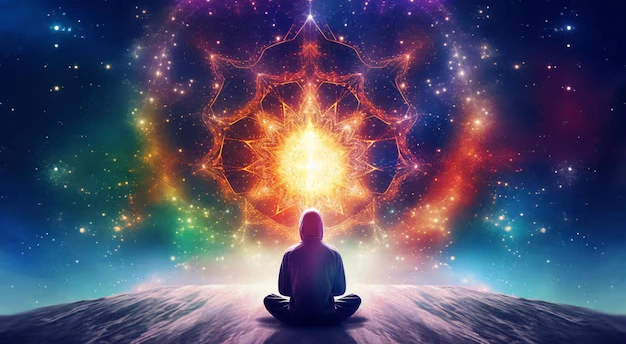
Introduction: The Sacred Language of the Soul
In the intricate tapestry of human existence, suffering emerges not merely as an unwelcome intruder but as a profound messenger carrying whispers from our deepest self. Throughout history, philosophers, spiritual teachers, and psychologists have recognized that our greatest discomforts often serve as the soul’s most urgent communiqués—signals flashing across the void between our authentic essence and our conscious awareness. This exploration delves into how adversity functions as a sophisticated language through which our innermost being attempts to redirect our attention to neglected aspects of our spiritual journey.
The ancient Greeks understood this phenomenon through the concept of pathei mathos—wisdom through suffering. As Aeschylus wrote in Agamemnon, “He who learns must suffer. And even in our sleep, pain that cannot forget falls drop by drop upon the heart, and in our own despair, against our will, comes wisdom to us by the awful grace of God.” This timeless insight invites us to reconsider our relationship with discomfort—not as punishment, but as sacred instruction.
The Spiritual Anatomy of Suffering: Beyond Pain to Purpose
Suffering transcends simple discomfort—it operates as an intricate mechanism designed to recalibrate our existence when we drift from our authentic path. Viktor Frankl, Holocaust survivor and psychiatrist, observed that “suffering ceases to be suffering at the moment it finds a meaning.” His logotherapy approach suggests that our pain carries purpose, waiting to be deciphered rather than merely endured.
Buddhist philosophy further illuminates this concept through the First Noble Truth—dukkha (suffering)—which posits that dissatisfaction is intrinsic to existence. However, rather than viewing this as cause for despair, Buddhism teaches that acknowledging suffering represents the initial step toward liberation. The Dalai Lama elegantly articulates this paradox: “Pain can change you, but that doesn’t mean it has to be a bad change. Take that pain and turn it into wisdom.”
Consider the chrysalis—for the emerging butterfly, the struggle to break free from its confining cocoon is precisely what strengthens its wings enough for flight. Remove this resistance, this suffering, and the butterfly remains forever earthbound. Similarly, our soul employs discomfort as resistance training, strengthening our spiritual musculature for the flights we are meant to undertake.
The Alchemy of Attention: Transforming Suffering Through Conscious Awareness
When we experience psychological or physical distress, we stand at a critical crossroads. We can anesthetize ourselves through various escapes—excessive work, substance use, digital distractions—or we can practice what philosopher Simone Weil called “attention,” the purest form of generosity we can offer ourselves. This quality of presence transforms suffering from mere pain into revelation.
The renowned psychiatrist Carl Jung observed this phenomenon throughout his clinical practice, noting: “There is no coming to consciousness without pain. People will do anything, no matter how absurd, in order to avoid facing their own soul. One does not become enlightened by imagining figures of light, but by making the darkness conscious.”
This “making the darkness conscious” represents the essential alchemy of spiritual growth—transmuting the lead of our suffering into the gold of self-knowledge. When we feel anxiety constricting our chest, depression weighing on our shoulders, or ambiguous physical symptoms manifesting in our bodies, these sensations often function as alarm systems indicating that we have strayed from authenticity or neglected crucial aspects of our spiritual development.
The Mind-Soul Schism: Material Existence vs. Spiritual Essence
In our contemporary landscape, dominated by materialistic metrics of success and algorithmic distractions, a profound disconnection often emerges between our cognitive focus on external achievements and our soul’s yearning for meaning, connection, and transcendence. This schism creates a spiritual cognitive dissonance that manifests as existential anxiety—the vague yet persistent sense that something essential remains unfulfilled despite external accomplishments.
Philosopher Martin Heidegger described this state as “forgetfulness of Being”—when humans become so entangled in the objects and concerns of everyday existence that they lose touch with the deeper question of what it means to exist authentically. This forgetfulness doesn’t disappear; rather, it haunts us through what Heidegger termed “anxiety” (Angst)—a fundamental mood that reveals our disconnection from authentic Being.
Consider the executive who achieves remarkable professional success while experiencing recurrent panic attacks, or the social media influencer surrounded by virtual admiration yet plagued by insomnia and chronic fatigue. These symptoms often represent the soul’s rebellion against a life that, while perhaps impressive from an external perspective, fails to nourish what Thomas Moore calls “the spirit’s sacred longing.”
The Symptomatology of Soul-Neglect: How Disconnection Manifests
When we consistently override our soul’s guidance, our bodies and minds often become the battleground where this conflict plays out. Psychoneuroimmunology—the study of how psychological processes influence our nervous and immune systems—provides compelling evidence that emotional distress directly impacts physical health, supporting what wisdom traditions have long asserted: the mind, body, and spirit exist in continuous dialogue.
Physician Gabor Maté’s research demonstrates how chronic stress and trauma manifest as physical illness, noting: “The body never lies.” The rising prevalence of autoimmune disorders—where the body essentially attacks itself—may symbolically represent the profound self-alienation endemic to modern existence, where individuals unconsciously suppress authentic needs and desires to conform to external expectations.
This manifestation operates on multiple levels:
- Emotional symptoms: Persistent anxiety, depression, or emotional numbness often signal spiritual malnourishment
- Cognitive symptoms: Rumination, difficulty concentrating, or existential questioning frequently indicate soul-yearning for deeper meaning
- Physical symptoms: Chronic fatigue, unexplained pain, or recurrent illness can represent embodied spiritual distress
- Relational symptoms: Pattern of unsatisfying connections or conflict may reflect internal spiritual disconnection
These symptoms intensify when ignored—much like a child whose whispers, when unheeded, escalate to screams to capture attention. The soul employs similar tactics, beginning with subtle nudges before progressing to more dramatic interventions when we repeatedly disregard its communication.
The Courageous Path: Befriending Discomfort as Sacred Guide
Healing begins with a radical shift in orientation—approaching suffering not as enemy but as teacher. This requires cultivating what Buddhist teacher Pema Chödrön calls “the wisdom of no escape”—the courage to remain present with discomfort rather than fleeing from it. As she notes, “Only to the extent that we expose ourselves over and over to annihilation can that which is indestructible be found in us.”
This approach invites us to develop what psychologists term “psychological flexibility”—the capacity to remain in contact with difficult experiences while continuing to move toward valued life directions. Rather than attempting to eliminate suffering (an ultimately futile endeavor), we learn to extract its essence, asking questions like:
- What truth is this discomfort revealing about my authentic needs?
- Which aspects of my life have I been neglecting that require attention?
- What beliefs or patterns am I clinging to that no longer serve my spiritual evolution?
- How might this struggle be preparing me for growth I cannot yet imagine?
Consider the story of Etty Hillesum, who wrote profound journals while in a Nazi concentration camp, observing: “By excluding death from our life, we cannot live a full life, and by admitting death into our life, we enlarge and enrich it.” Her capacity to find spiritual enlargement even amid extreme suffering demonstrates the human potential to transmute pain into transcendence.
Practical Integration: Honoring the Soul’s Voice in Daily Life
Transforming our relationship with suffering requires practical methodologies, not merely philosophical understanding. Several approaches facilitate this integration:
Contemplative Practice: Regular meditation, prayer or mindfulness creates space to hear the soul’s whispers before they become shouts. As Thomas Merton observed, “In silence and solitude we find the place where God’s language can be heard and understood.”
Embodied Awareness: Somatic practices like yoga, tai chi, or conscious movement help us recognize how emotional and spiritual states manifest physically, allowing us to decode bodily sensations as meaningful communications rather than inconveniences.
Dream Work: Dreams often serve as direct communications from our deeper self. Keeping a dream journal and contemplating recurring themes provides insight into what Jung called “the unconscious knowledge of the soul.”
Creative Expression: Artistic pursuits offer the soul alternative languages when words prove insufficient. Through painting, music, dance, or writing, we access dimensions of understanding that transcend logical comprehension.
Therapeutic Dialogue: Working with skilled therapists, particularly those versed in depth psychology, can help translate the seemingly chaotic language of symptoms into coherent messages about our spiritual needs.
Nature Immersion: Regular communion with the natural world reconnects us with rhythms and wisdom beyond human construction, providing perspective on our suffering within larger cycles of death and rebirth.
Conclusion: The Luminous Darkness
Our suffering, while painful, ultimately serves as evidence of our profound capacity for growth and transformation. As philosopher Pierre Teilhard de Chardin observed, “We are not human beings having a spiritual experience; we are spiritual beings having a human experience.” Our discomfort often marks the growing edges of this spiritual journey—the places where we are being invited to expand beyond comfortable limitations.
The 13th-century Sufi poet Rumi captured this paradoxical wisdom in his poem “The Guest House”:
This being human is a guest house.
Every morning a new arrival.
A joy, a depression, a meanness,
some momentary awareness comes
as an unexpected visitor.
Welcome and entertain them all!
By welcoming suffering as such a visitor—treating it with curious respect rather than fearful avoidance—we discover that our pain contains not only messages but also gifts. Through this courageous engagement, we transform our relationship with suffering from adversarial to alchemical, ultimately recognizing that the soul speaks most clearly through our wounds—not to diminish us, but to guide us toward our most authentic expression of being.
In this light, suffering becomes not the enemy of fulfillment but its unexpected ally—the necessary darkness that reveals, by contrast, our capacity for inner light.
ARE YOU A SPIRITUAL PERSON?
Let’s see if your outlook is more ethereal and transcendental, or if you’re completely focused on the physical world and its dynamics. In other words, are you taking care of your soul as well?
Review the following statements and check the ones you agree with and consider best aligned with your perspective.
Count the number of checked boxes and read the corresponding profile.
0: You are not spiritual at all
1-2: You are hardly spiritual
3-4: You are quite spiritual
5-6: You are very spiritual






Very particular interpretation of suffering, it made me think that we should not push suffering away but try to understand it….